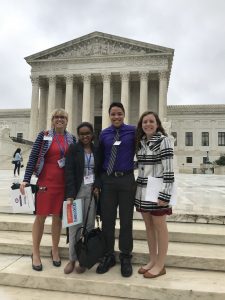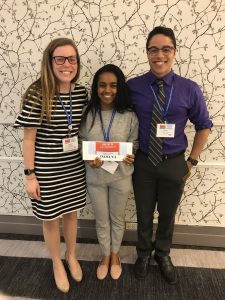Gunshots, victims, prayers: According to the Centers for Disease Control and Prevention, this is an all-too-familiar cycle in the United States. Nov. 7 marked the nation’s 307th mass shooting in 2018 alone, in Thousand Oaks, California. The Gun Violence Archive, which catalogs each incident of gun violence in the United States every year, found that there have been 313 mass shootings in 2018, as of Nov. 18, which means an average of one act of gun violence per day. This is nothing new. Last year saw a total of 346 mass shootings, and 2016 saw 384.
From left to right: Heidi Hancher-Rauch, Yordanos Gebru, Shawn Schweitzer and Megan Davish presented “Strategies for the Novice Advocate: Creating Advocacy Plans to Fight Gun Violence” in Washington, D.C.
The Washington Post’s article “The terrible numbers that grow with each mass shooting” notes that there is no universally accepted definition of a mass shooting. However, the Gun Violence Archive, which gathers information from more than 2,500 media, law enforcement, government and commercial sources daily, defines mass shooting as a shooting in which at least four people are injured or killed in one location, not including the suspect.
In the wake of these acts of violence, numerous groups have arisen to advocate for gun safety. One such group is the Society for Public Health Education, a nonprofit association that represents nearly 4,000 health education professionals in the United States and 25 other countries. Each year, SOPHE hosts an advocacy summit on a different public health concern. This year, the priority issue was gun violence in the United States. Associate Professor of Kinesiology Heidi Hancher-Rauch is a member of the SOPHE advocacy committee. This year, Rauch sponsored three students to attend and present at the summit in October.
“I think a couple of things stand out from an experience like that. And one of them was an opportunity for the students,” Rauch said. “It was their first professional presentation for a national audience. So that’s always exciting to be a part of with students, to give them that opportunity to speak on something they feel passionate about.”
According to SOPHE’s website, its annual Advocacy Summit is a two-and-a-half-day meeting held in Washington, D.C. Its goal is to “increase the capacity of health education professionals and students to engage in effective advocacy for a common health education agenda at national, state, and local levels.”
“Keep advocating, keep pushing for change, because if we are silent, we’re complicit.”
The first day-and-a-half is spent learning. This involves multiple sessions about varying levels of advocacy training, as well as seminars led by government relations staff. Attendees have the opportunity to learn how to discuss important legislation and brainstorm with state delegations. This all culminates into the final day of the Summit, which is spent on Capitol Hill. Each attendee makes one or more visits to a Congressional office. Once the summit is over, those involved are encouraged to continue to advocate within their local communities.
The three students involved in the Summit were senior public health major Megan Davish and public health graduate students Shawn Schweitzer and Yordanos Gebru. Davish said the experience had a remarkable impact on her.
“I learned a crazy amount on gun violence from this experience,” Davish said. “We actually got to meet with legislative aids from [Sen.] Joe Donnelly’s office, [Sen.] Todd Young’s office. … And it was such an amazing experience to actually sit down and have those conversations, [to] say, ‘I’m here representing the Society for Public Health Education, [and] this is what we want to see happen. This is why it’s a problem.’”
Together, Davish, Schweitzer, Gebru and Rauch created an advocacy plan about gun violence. This advocacy plan primarily involved information on the state of gun violence in the U.S. and how to become advocates for safety as a whole, including how to start crucial conversations and take action for change. This final advocacy plan was submitted near the end of May and eventually was accepted by the committee. Then in October, they presented their findings at the conference.
“We kind of started just talking about gun violence in general—what is this, why is this important, giving statistics,” Davish said. “After that, we talked about why it was important to have these conversations, and then the different skills you need to be an advocate—being professional, having a good media presence, being empathetic with your priority population; and then the different steps of making an advocacy plan.”
Davish was the lead on the advocacy plan. She said that gun violence is a three-tiered issue. A large part of what the media cover tends to be focused on mass public shootings. Davish said that while this is not necessarily a bad thing, little attention is focused on suicides, homicides and partner violence caused by guns.
“In the United States, 22,000 Americans every year actually commit suicide using a firearm. That is a crazy amount,” Davish said. “That’s two thirds of all gun deaths in the United States, and it’s something we just don’t think about.”
From left to right, Megan Davish, Yordanos Gebru and Shawn Schweitzer at the presentation in D.C. Gebru and Schweitzer are both studying for a Masters in Public Health, while Davish is a undergrad in Public Health.
Both Davish and Rauch agreed that being equipped with knowledge is one of the best ways to combat gun violence, particularly when advocating for change within the legal system. They noted that gun policy is left entirely to the states, and so each individual advocate must look at what the laws say in his or her state in order to make a real difference.
“Those one-time rallies and events are great, but you can make a bigger difference if you contact your legislators regularly,” Rauch said. “In this last election, Moms Demand Action was one of the groups that went through and had conversations with all of the candidates, asked them about their position on common sense gun laws and graded candidates as either gun sense candidates or not. So that’s information that’s readily out there. Use that when you go to the polls. Know who and what it is you’re voting for.”
According to both Davish and Rauch, Indiana has areas to improve upon when it comes to protective legislation. Rauch said that despite the fact that the rates of gun violence are higher in Illinois, people often will acquire their guns in Indiana first, because of the ease of access. Davish said that she would like to see the minimum age requirement for a gun be raised above 18. Both agree, however, that there have been steps taken in the right direction. For example, according to Davish, Indiana does have in place a child access prevention law. According to the Giffords Law Center, in Indiana, the child access prevention law states that a legal guardian commits the crime of “dangerous control of a child” if he or she “knowingly, intentionally, or recklessly” allows the child to possess a firearm. Rauch said that Indiana also has a red flag law.
“In Indiana, there’s a red flag law that allows—if somebody is deemed potentially harmful to others—you call your local police officers,” Rauch said. “They go to the house, and if they find the person at the house is truly a potential harm, they can take the weapons for a short amount of time.”
Both Rauch and Davish said that there are multiple opportunities for young advocates for gun safety. Numerous organizations, such as Moms Demand Action, have student chapters that allow young people to get involved. Other organizations, such as Every Town Against Gun Violence, allow everyone to join. Rauch and Davish agree that, at the end of the day, all people want safety.
“Keep advocating, keep pushing for change, because if we are silent, we’re complicit,” Davish said. “If we’re not on the front lines trying to make that change, we are accepting, and saying it is what it is.”








